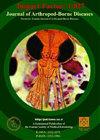A Comprehensive Review of the Situation of Visceral Leishmaniasis Vectors in Iran
IF 0.6
4区 医学
Q4 PARASITOLOGY
引用次数: 0
Abstract
Background: This study's major aim is to investigate the situation of visceral leishmaniasis vectors, with a focus on their distribution and relationships to the disease in Iran and some other old-world nations. Methods: The terms Iran and the Old World, along with the keywords sand flies, vectors, visceral leishmaniasis, distribution, and Phlebotomus, were searched in electronic databases from 1930 to 2018, including Pub-Med, Web of Science, Google Scholar, and MEDLINE. Results: According to the findings, Phlebotomus tobbi was a mountain species, but it was also found in the plains, rodent nests, and rock crevices. This species was considered to be one of the vectors of visceral leishmaniasis in Iran. Phlebotomus kandelakii has been caught in Afghanistan, Iran, Lebanon, Turkey and Georgia. In Iran, the first infection of Phlebotomus kandelakii and Ph. perfiliewi transcaucasicus with Leishmania infantum were reported in northwest of Iran. Phlebotomus major was one of the complex sand flies, and its members include Ph. major (India, Nepal, and Pakistan), Ph. neglectus (Southern Europe, Crimea and Iran), Ph. syriacus (Southwest Asia, Caucasus), Ph. notus (Afghanistan and Iran), Ph. wenyoni (Iran and Iraq), and Ph. wui (China). The first natural infection of Ph. alexandri with Leishmania infantum was reported in 2006 in endemic foci of visceral leishmaniasis in Fars Province, southern Iran. Conclusion: The findings of this project suggest that sand fly species of the subgenus Larrousisus play a key role in the transmission of all types of visceral leishmaniasis in Iran.伊朗内脏利什曼病病媒状况全面回顾
背景:本研究的主要目的是调查内脏利什曼病病媒的情况,重点是它们在伊朗和其他一些旧世界国家的分布及其与该疾病的关系。研究方法:以伊朗和旧世界为术语,以沙蝇、病媒、内脏利什曼病、分布和Phlebotomus为关键词,在1930年至2018年的电子数据库中进行了检索,包括Pub-Med、Web of Science、Google Scholar和MEDLINE。结果:根据研究结果,Phlebotomus tobbi是一种山区物种,但在平原、啮齿动物巢穴和岩石缝隙中也有发现。该物种被认为是伊朗内脏利什曼病的病媒之一。阿富汗、伊朗、黎巴嫩、土耳其和格鲁吉亚都曾捕获过 Phlebotomus kandelakii。伊朗西北部首次报告了 Phlebotomus kandelakii 和 Ph. perfiliewi transcaucasicus 感染婴儿利什曼病。Phlebotomus major 是复合沙蝇之一,其成员包括 Ph. major(印度、尼泊尔和巴基斯坦)、Ph. neglectus(南欧、克里米亚和伊朗)、Ph. syriacus(西南亚、高加索)、Ph. notus(阿富汗和伊朗)、Ph. wenyoni(伊朗和伊拉克)和 Ph. wui(中国)。2006 年,在伊朗南部法尔斯省的内脏利什曼病流行区,首次报告了 Ph. alexandri 与婴儿利什曼原虫的自然感染。结论本项目的研究结果表明,Larrousisus 亚属的沙蝇物种在伊朗各种类型的内脏利什曼病传播中起着关键作用。
本文章由计算机程序翻译,如有差异,请以英文原文为准。
求助全文
约1分钟内获得全文
求助全文
来源期刊

Journal of Arthropod-Borne Diseases
PUBLIC, ENVIRONMENTAL & OCCUPATIONAL HEALTH-PARASITOLOGY
CiteScore
2.00
自引率
11.10%
发文量
17
审稿时长
8 weeks
期刊介绍:
The journal publishes original research paper, short communication, scientific note, case report, letter to the editor, and review article in English. The scope of papers comprises all aspects of arthropod borne diseases including:
● Systematics
● Vector ecology
● Epidemiology
● Immunology
● Parasitology
● Molecular biology
● Genetics
● Population dynamics
● Toxicology
● Vector control
● Diagnosis and treatment and other related subjects.
 求助内容:
求助内容: 应助结果提醒方式:
应助结果提醒方式:


